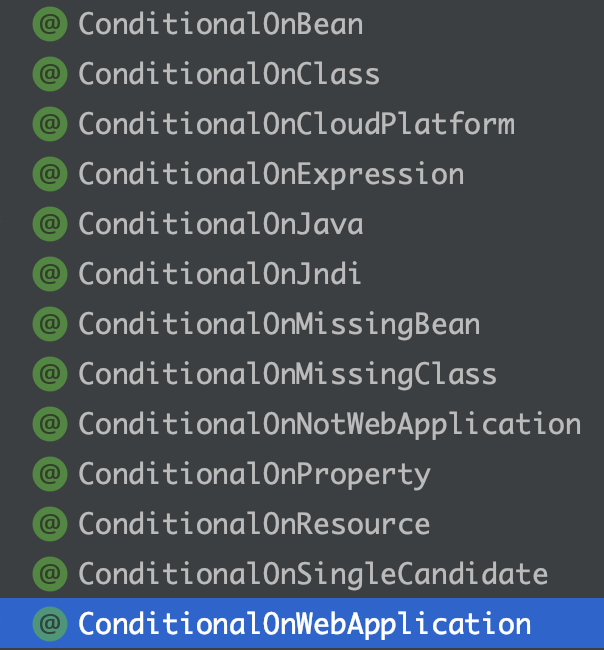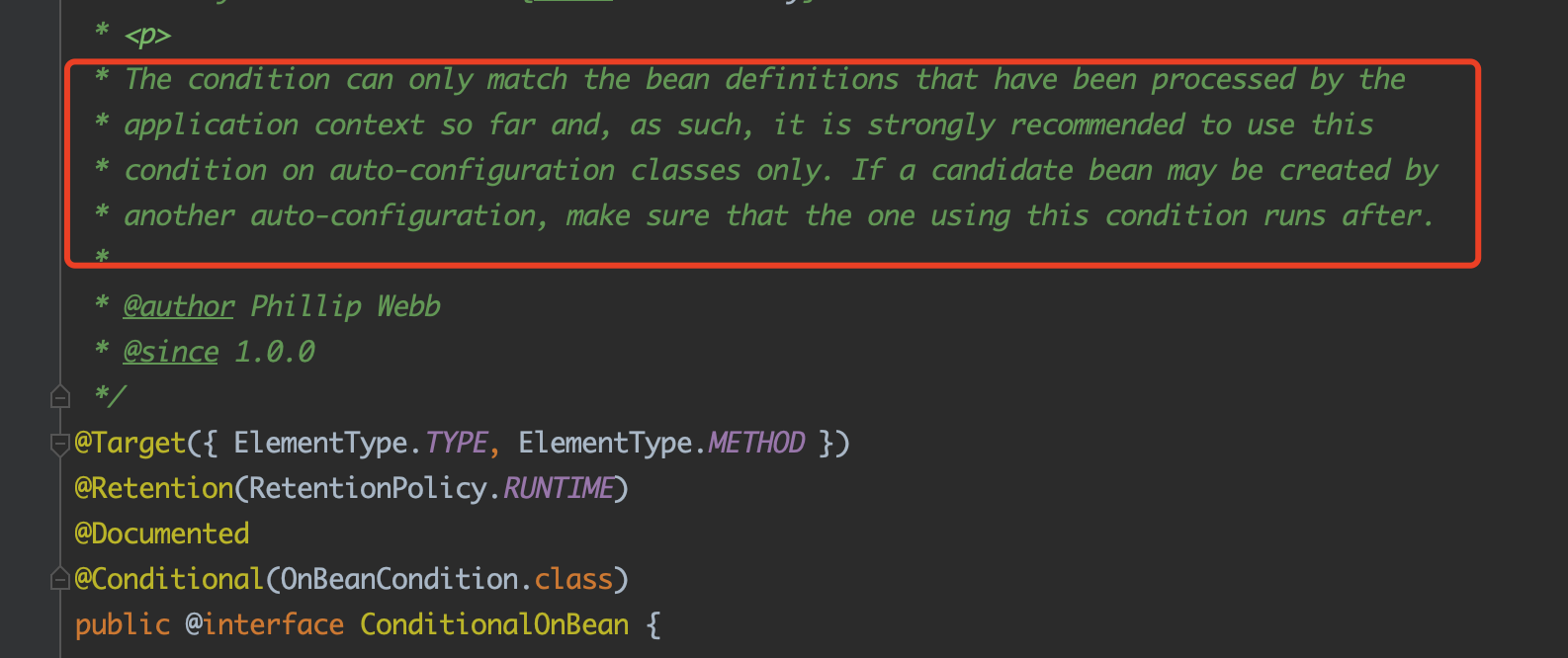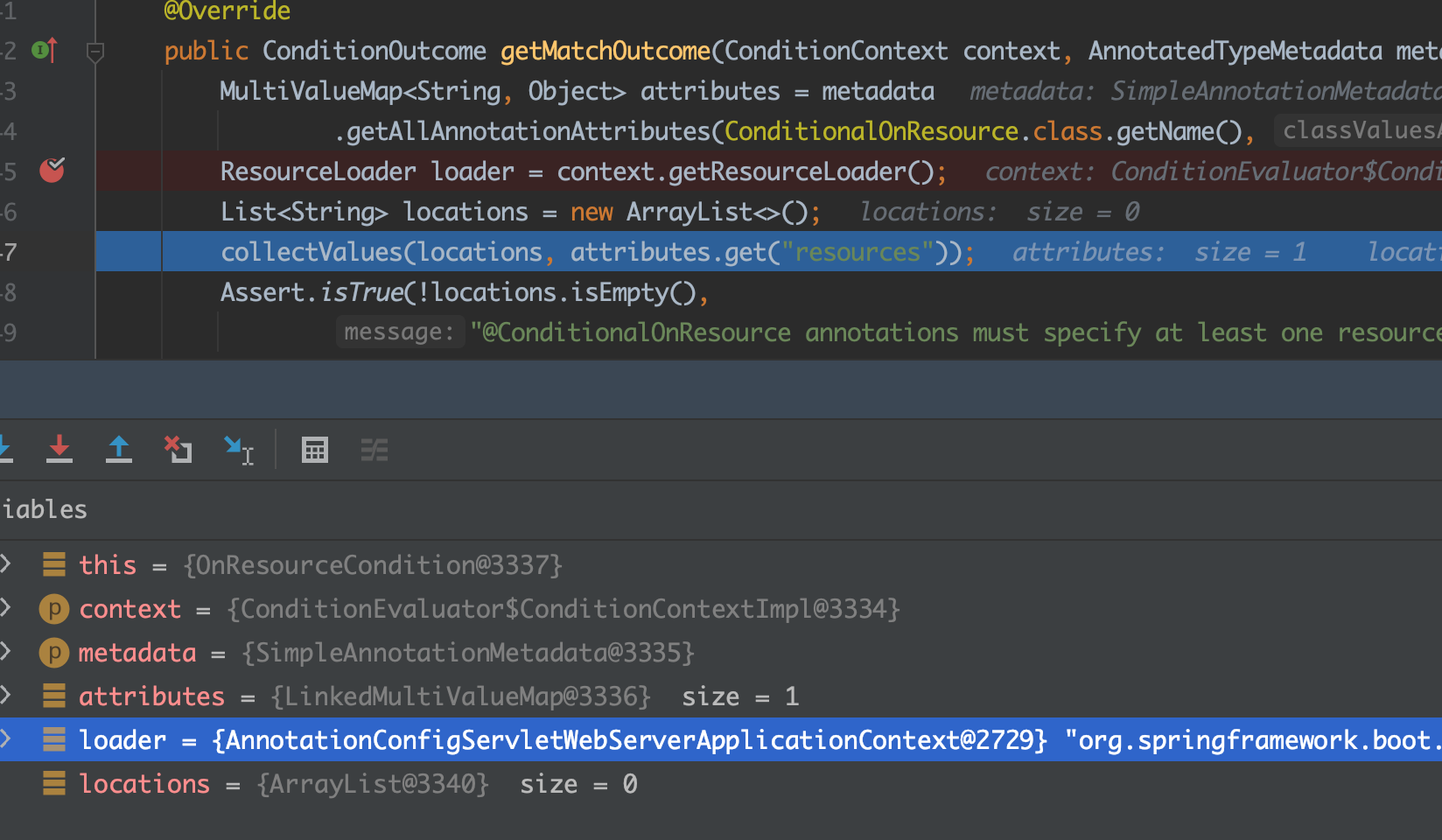在 springboot 自动装配之加载自动装配类一文中,我们分析到 springboot 会加载 META-INF/spring.factories 文件中定义的自动装配类,加载到这些自动装配类后,这些类中的 bean 就一定会初始化吗?并不是,我们可以在对应的 Bean 生成方法上使用条件注解来控制类是否进行初始化!
springboot 提供的条件注解如下:
这里列举部分如下:
| 注解类型 | 注解类型 | 功能说明 |
|---|---|---|
| class 条件注解 | @ConditionalOnClass/@ConditionalOnMissingClass |
当指定的类存在 / 缺失时初始化该 bean |
| bean 条件注解 | @ConditionalOnBean/@ConditionalOnMissingBean |
当指定的 bean 存在 / 缺失时初始化该 bean |
| 属性条件注解 | @ConditionalOnProperty |
当指定的属性存在初始化该 bean |
| Resource 条件注解 | @ConditionalOnResource |
当指定的资源存在初始化该 bean |
| Web 应用条件注解 | @ConditionalOnWebApplication / @ConditionalOnNotWebApplication |
当前应用为 / 不为 web 应用时初始化该 bean |
| spring 表达式条件注解 | @ConditionalOnExpression |
当表达式结果为 true 时初始化该 bean |
我们进入 @ConditionalOnClass 看看该注解的内容:
...
@Conditional(OnClassCondition.class)
public @interface ConditionalOnClass {
...
}
可以看到,ConditionalOnClass 组合了 @Conditional 注解的功能,处理类是 OnClassCondition.class。
关于 @Conditional 注解可以参考 ConfigurationClassPostProcessor 之处理 @Conditional 注解,这里我们直接说 @Conditional 的使用方式:
-
@Conditional是 spring 处理的条件注解; -
@Conditional提供了一个属性value,类型为Class,其必须是Condition的子类:Class<? extends Condition>[] value(); -
Condition是一个接口,其中有一个matches(...)方法:public interface Condition { boolean matches(ConditionContext context, AnnotatedTypeMetadata metadata); }只有在
matches(...)方法返回true时,ConfigurationClassPostProcessor才会将其对应的 bean 注册到beanFactory的beanDefinitionMap中.
总结完 @Conditional 的使用方式后,我们就明白了:OnClassCondition.class 是 Condition 的子类,其 matches(...) 方法用来处理主要条件规则。同理,其他条件注解的处理方式也类似,这里总结下条件注解的判断类:
| 注解类型 | 注解类型 | 条件判断类 |
|---|---|---|
| class 条件注解 | @ConditionalOnClass/@ConditionalOnMissingClass |
OnClassCondition |
| bean 条件注解 | @ConditionalOnBean/@ConditionalOnMissingBean |
OnBeanCondition |
| 属性条件注解 | @ConditionalOnProperty |
OnPropertyCondition |
| Resource 条件注解 | @ConditionalOnResource |
OnResourceCondition |
| Web 应用条件注解 | @ConditionalOnWebApplication / @ConditionalOnNotWebApplication |
OnWebApplicationCondition |
| spring 表达式条件注解 | @ConditionalOnExpression |
OnExpressionCondition |
接下来,分析目的就很明确了:要分析这些条件注解的判断逻辑,只需要分析对应条件判断类的 matches(...) 方法就可以了。
进入 OnClassCondition#matches 方法,发现来到的是 SpringBootCondition,相关方法如下:
public abstract class SpringBootCondition implements Condition {
private final Log logger = LogFactory.getLog(getClass());
@Override
public final boolean matches(ConditionContext context, AnnotatedTypeMetadata metadata) {
String classOrMethodName = getClassOrMethodName(metadata);
try {
// 获取条件匹配结果
ConditionOutcome outcome = getMatchOutcome(context, metadata);
// 打印一条日志
logOutcome(classOrMethodName, outcome);
// 记录条件评估的发生,简单理解为记录一条条件判断记录吧
recordEvaluation(context, classOrMethodName, outcome);
// 这里返回最终结果:true 或 false
return outcome.isMatch();
}
catch (NoClassDefFoundError ex) {
throw new IllegalStateException(...);
}
catch (RuntimeException ex) {
throw new IllegalStateException(...);
}
}
/**
* 这是个抽象方式,具体内容由子类实现
*/
public abstract ConditionOutcome getMatchOutcome(
ConditionContext context, AnnotatedTypeMetadata metadata);
...
}
SpringBootCondition 的 matches(...) 关键就两行:
...
ConditionOutcome outcome = getMatchOutcome(context, metadata);
...
return outcome.isMatch();
而 SpringBootCondition 的 getMatchOutcome(...) 又是个抽象方法,具体的逻辑由子类提供,OnClassCondition 它的实现之一。实际上,上述条件判断类都是 SpringBootCondition 的子类,后面我们就直接进入具体类的 getMatchOutcome(...) 方法分析了。
getMatchOutcome(...) 方法返回的结果是 ConditionOutcome,接下来我们来看看 ConditionOutcome 是个啥:
public class ConditionOutcome {
private final boolean match;
private final ConditionMessage message;
/**
* 构造方法
*/
public ConditionOutcome(boolean match, String message) {
this(match, ConditionMessage.of(message));
}
/**
* 构造方法
*/
public ConditionOutcome(boolean match, ConditionMessage message) {
Assert.notNull(message, "ConditionMessage must not be null");
this.match = match;
this.message = message;
}
/**
* 返回匹配的结果
*/
public boolean isMatch() {
return this.match;
}
...
}
从代码来看,这个类就是用来封装比较结果的,内部有两个属性:match 与 message:
match的类型是boolean,这个就是最终匹配成功还是失败的标识message的类型是ConditionMessage,它表示匹配结果的说明
我们再来看看 ConditionMessage:
public final class ConditionMessage {
private String message;
private ConditionMessage() {
this(null);
}
private ConditionMessage(String message) {
this.message = message;
}
...
}
它仅有一个属性:message,这表明它就是对说明信息的包装。
接下来我们来分析 OnClassCondition 的匹配逻辑,直接进入 getMatchOutcome 方法:
public ConditionOutcome getMatchOutcome(ConditionContext context, AnnotatedTypeMetadata metadata) {
ClassLoader classLoader = context.getClassLoader();
ConditionMessage matchMessage = ConditionMessage.empty();
// 1\. 处理 @ConditionalOnClass 注解
List<String> onClasses = getCandidates(metadata, ConditionalOnClass.class);
if (onClasses != null) {
// 1.1 处理条件判断
List<String> missing = filter(onClasses, ClassNameFilter.MISSING, classLoader);
if (!missing.isEmpty()) {
// 1.2 构建返回结果:不匹配的情况
return ConditionOutcome.noMatch(ConditionMessage.forCondition(ConditionalOnClass.class)
.didNotFind("required class", "required classes").items(Style.QUOTE, missing));
}
matchMessage = matchMessage.andCondition(ConditionalOnClass.class)
.found("required class", "required classes")
.items(Style.QUOTE, filter(onClasses, ClassNameFilter.PRESENT, classLoader));
}
// 2\. 处理 @ConditionalOnMissingClass 注解
List<String> onMissingClasses = getCandidates(metadata, ConditionalOnMissingClass.class);
if (onMissingClasses != null) {
// 2.1 处理条件判断
List<String> present = filter(onMissingClasses, ClassNameFilter.PRESENT, classLoader);
if (!present.isEmpty()) {
// 2.2 构建返回结果:不匹配的情况
return ConditionOutcome.noMatch(ConditionMessage
.forCondition(ConditionalOnMissingClass.class)
.found("unwanted class", "unwanted classes").items(Style.QUOTE, present));
}
matchMessage = matchMessage.andCondition(ConditionalOnMissingClass.class)
.didNotFind("unwanted class", "unwanted classes")
.items(Style.QUOTE, filter(onMissingClasses, ClassNameFilter.MISSING, classLoader));
}
// 最后返回匹配的结果
return ConditionOutcome.match(matchMessage);
}
这个方法同时处理了 @ConditionalOnClass 与 @ConditionalOnMissingClass 两个注解,处理流程极其相似,两个注解的条件判断都是通过 FilteringSpringBootCondition#filter 内容如下:
protected final List<String> filter(Collection<String> classNames, ClassNameFilter classNameFilter,
ClassLoader classLoader) {
if (CollectionUtils.isEmpty(classNames)) {
return Collections.emptyList();
}
List<String> matches = new ArrayList<>(classNames.size());
for (String candidate : classNames) {
// 进行条件匹配
if (classNameFilter.matches(candidate, classLoader)) {
matches.add(candidate);
}
}
return matches;
}
由此可见,传入的 classNameFilter 成了关键:
- 处理
@ConditionalOnClass时,classNameFilter为ClassNameFilter.MISSING - 处理
@ConditionalOnMissingClass时,classNameFilter为ClassNameFilter.PRESENT
让我们进入 ClassNameFilter 一探究竟,它是 FilteringSpringBootCondition 的子类,内容如下:
abstract class FilteringSpringBootCondition extends SpringBootCondition
implements AutoConfigurationImportFilter, BeanFactoryAware, BeanClassLoaderAware {
...
/**
* 如果 classLoader 存在,则调用 ClassLoader#loadClass 方法
* 否则调用 Class#forName 方法
*/
protected static Class<?> resolve(String className, ClassLoader classLoader)
throws ClassNotFoundException {
if (classLoader != null) {
return classLoader.loadClass(className);
}
return Class.forName(className);
}
/**
* 处理条件匹配
*/
protected enum ClassNameFilter {
PRESENT {
@Override
public boolean matches(String className, ClassLoader classLoader) {
return isPresent(className, classLoader);
}
},
MISSING {
@Override
public boolean matches(String className, ClassLoader classLoader) {
return !isPresent(className, classLoader);
}
};
abstract boolean matches(String className, ClassLoader classLoader);
/**
* Class 是否存在
* 通过捕获类加载时的异常来判断类是否存在,未抛出异常则表示类存在
*/
static boolean isPresent(String className, ClassLoader classLoader) {
if (classLoader == null) {
classLoader = ClassUtils.getDefaultClassLoader();
}
try {
// 通过异常捕获来判断是否存在该class
resolve(className, classLoader);
return true;
}
catch (Throwable ex) {
return false;
}
}
}
...
}
看到这里我们就明白了:判断 Class 是否存在,spring 是通过捕获 ClassLoader.load(String) 或 Class.forName(String) 方法的异常来处理的,如果抛出了异常就表明 Class 不存在。
这里总结下 @ConditionalOnClass/@ConditionalOnMissingClass 的处理方式:两者的处理类都为 OnClassCondition,通过捕获 ClassLoader.load(String) 或 Class.forName(String) 方法的异常来判断 Class 是否存在,如果抛出了异常就表明 Class 不存在。
继续看看 @ConditionalOnBean 的 处理,直接进入 OnBeanCondition#getMatchOutcome:
public ConditionOutcome getMatchOutcome(ConditionContext context, AnnotatedTypeMetadata metadata) {
ConditionMessage matchMessage = ConditionMessage.empty();
MergedAnnotations annotations = metadata.getAnnotations();
// 处理 @ConditionalOnBean
if (annotations.isPresent(ConditionalOnBean.class)) {
Spec<ConditionalOnBean> spec = new Spec<>(context, metadata,
annotations, ConditionalOnBean.class);
// 处理匹配
MatchResult matchResult = getMatchingBeans(context, spec);
// 注意判断条件
if (!matchResult.isAllMatched()) {
String reason = createOnBeanNoMatchReason(matchResult);
return ConditionOutcome.noMatch(spec.message().because(reason));
}
matchMessage = spec.message(matchMessage).found("bean", "beans").items(Style.QUOTE,
matchResult.getNamesOfAllMatches());
}
// 处理 @ConditionalOnSingleCandidate
if (metadata.isAnnotated(ConditionalOnSingleCandidate.class.getName())) {
Spec<ConditionalOnSingleCandidate> spec
= new SingleCandidateSpec(context, metadata, annotations);
// 处理匹配
MatchResult matchResult = getMatchingBeans(context, spec);
// 注意判断条件
if (!matchResult.isAllMatched()) {
return ConditionOutcome.noMatch(spec.message().didNotFind("any beans").atAll());
}
else if (!hasSingleAutowireCandidate(context.getBeanFactory(),
matchResult.getNamesOfAllMatches(), spec.getStrategy() == SearchStrategy.ALL)) {
return ConditionOutcome.noMatch(spec.message().didNotFind("a primary bean from beans")
.items(Style.QUOTE, matchResult.getNamesOfAllMatches()));
}
matchMessage = spec.message(matchMessage).found("a primary bean from beans")
.items(Style.QUOTE, matchResult.getNamesOfAllMatches());
}
// 处理 @ConditionalOnMissingBean
if (metadata.isAnnotated(ConditionalOnMissingBean.class.getName())) {
Spec<ConditionalOnMissingBean> spec = new Spec<>(context, metadata, annotations,
ConditionalOnMissingBean.class);
// 处理匹配
MatchResult matchResult = getMatchingBeans(context, spec);
// 注意判断条件
if (matchResult.isAnyMatched()) {
String reason = createOnMissingBeanNoMatchReason(matchResult);
return ConditionOutcome.noMatch(spec.message().because(reason));
}
matchMessage = spec.message(matchMessage).didNotFind("any beans").atAll();
}
return ConditionOutcome.match(matchMessage);
}
可以看到,这个方法一共处理了两个注解的条件匹配:@ConditionalOnBean、@ConditionalOnSingleCandidate 与 @ConditionalOnMissingBean,三者都调用了同一个方法 getMatchingBeans(...) 来获取匹配结果,然后使用 matchResult.isAllMatched() 或 matchResult.isAnyMatched() 来做最终的结果判断。
getMatchingBeans(...) 的代码如下:
protected final MatchResult getMatchingBeans(ConditionContext context, Spec<?> spec) {
ClassLoader classLoader = context.getClassLoader();
ConfigurableListableBeanFactory beanFactory = context.getBeanFactory();
boolean considerHierarchy = spec.getStrategy() != SearchStrategy.CURRENT;
Set<Class<?>> parameterizedContainers = spec.getParameterizedContainers();
if (spec.getStrategy() == SearchStrategy.ANCESTORS) {
BeanFactory parent = beanFactory.getParentBeanFactory();
Assert.isInstanceOf(ConfigurableListableBeanFactory.class, parent,
"Unable to use SearchStrategy.ANCESTORS");
beanFactory = (ConfigurableListableBeanFactory) parent;
}
MatchResult result = new MatchResult();
// 1\. 获取 ignoreType,只有 @ConditionalOnMissingBean 有这个属性
Set<String> beansIgnoredByType = getNamesOfBeansIgnoredByType(classLoader, beanFactory,
considerHierarchy, spec.getIgnoredTypes(), parameterizedContainers);
// 2\. 处理 types
for (String type : spec.getTypes()) {
Collection<String> typeMatches = getBeanNamesForType(classLoader, considerHierarchy,
beanFactory, type, parameterizedContainers);
typeMatches.removeAll(beansIgnoredByType);
if (typeMatches.isEmpty()) {
result.recordUnmatchedType(type);
}
else {
result.recordMatchedType(type, typeMatches);
}
}
// 3\. 处理类上的注解 @ConditionalOnMissingBean 有这个属性
for (String annotation : spec.getAnnotations()) {
Set<String> annotationMatches = getBeanNamesForAnnotation(classLoader, beanFactory,
annotation, considerHierarchy);
annotationMatches.removeAll(beansIgnoredByType);
if (annotationMatches.isEmpty()) {
result.recordUnmatchedAnnotation(annotation);
}
else {
result.recordMatchedAnnotation(annotation, annotationMatches);
}
}
// 4\. 处理 beanName
for (String beanName : spec.getNames()) {
if (!beansIgnoredByType.contains(beanName) && containsBean(beanFactory, beanName,
considerHierarchy)) {
result.recordMatchedName(beanName);
}
else {
result.recordUnmatchedName(beanName);
}
}
return result;
}
需要说明的是,这个方法会处理 3 个注解的匹配规则:@ConditionalOnBean、@ConditionalOnSingleCandidate 与 @ConditionalOnMissingBean,处理步骤如下:
- 获取
ignoreType,只有@ConditionalOnMissingBean有这个属性 - 处理
types的匹配规则 - 处理注解(类上的注解)的匹配规则, 只有
@ConditionalOnMissingBean有这个属性 - 处理
beanName的匹配规则
关于以上步骤的具体细节,本文就不具体展开了,这里仅提供流程:
- 获取
ignoreType:- 使用
ListableBeanFactory#getBeanNamesForType(Class, boolean, boolean)方法获取容器中所有的ignoreType的beanName - 结果为
beansIgnoredByType(类型是Set<String>)
- 使用
- 处理
types的匹配规则- 使用
ListableBeanFactory#getBeanNamesForType(Class, boolean, boolean)方法获取容器中所有的type对应的beanName,结果为typeMatches - 将
typeMatches中的值去除ignoreType - 判断第二步得到的
typeMatches,如果内容为空,将当前Type保存到unmatchedTypes中,否则保存到matchedTypes与namesOfAllMatches中
- 使用
- 处理注解的匹配规则
- 使用
ListableBeanFactory#getBeanNamesForAnnotation方法获取容器中所有的annotation对应的beanName,结果为annotationMatches - 将
annotationMatches中的值去除ignoreType - 判断第二步得到的
annotationMatches,如果内容为空,将当前Annotation保存到unmatchedAnnotations中,否则保存到matchedAnnotations与namesOfAllMatches中
- 使用
- 处理
beanName的匹配规则- 判断
beansIgnoredByType是否包含beanName - 使用
BeanFactory#containsBean方法判断容器中有该beanName - 如果第 2 步结果为
false,第二步结果为true,则将当前beanName加入到matchedNames与namesOfAllMatches,否则保存到unmatchedNames中
- 判断
得到 matchedTypes、unmatchedNames 等内容后,matchResult.isAllMatched() 或 matchResult.isAnyMatched() 最终的判断结果就是判断这些结构是否空:
boolean isAllMatched() {
return this.unmatchedAnnotations.isEmpty() && this.unmatchedNames.isEmpty()
&& this.unmatchedTypes.isEmpty();
}
boolean isAnyMatched() {
return (!this.matchedAnnotations.isEmpty()) || (!this.matchedNames.isEmpty())
|| (!this.matchedTypes.isEmpty());
}
看来,@ConditionalOnBean/@ConditionalOnMissingBean 的关键,就是使用 ListableBeanFactory#getBeanNamesForType 或 BeanFactory#containsBean 来判断 beanName、beanType 是否存在了。
在使用 @ConditionalOnBean/@ConditionalOnMissingBean 时,有一个坑需要特别注意:条件注解的执行时机是在 spring 的 ConfigurationClassPostProcessor 中的,确切地说,是在将 bean 加入到 beanFactory 的 beanDefinitionMap 之前判断的,如果满足条件则添加到 beanDefinitionMap 中,否则就不添加。这样就导致了一个问题:如果在 @ConditionalOnBean/@ConditionalOnMissingBean 的 bean 在该 bean 之后加入到 beanDefinitionMap 中,就有可能出现误判,举例说明:
现在有两个类:
@Component
@ConditionalOnMissingBean("b")
public class A {
}
@Component
public class B {
}
其中 A 与 B 都添加了 @Component,表明这是 spring bean,然后在 A 上添加了注解 @ConditionalOnMissingBean("b"),表明在 b 不存在时,A 才进行初始化。有了这些前提,我们再来看看两种情况:
- 如果
b先添加到beanDefinitionMap中,在将a添加到beanDefinitionMap时,发现b已经存在了,于是就不添加了,符合我们的预期; - 如果
a先被处理,在添加时,发现beanDefinitionMap中并没有b,于是a被添加到beanDefinitionMap中,再处理b,b也会被添加到beanDefinitionMap,这样一来,a与b同时存在于beanDefinitionMap中,最终都会被初始化成 spring bean,这与我们的预期不符。
那么 springboot 如何解决以上问题呢?我们来看看 @ConditionalOnBean/@ConditionalOnMissingBean 的说明:
稍微翻译如下:
该条件只能匹配到目前为止的应用程序上下文中的 bean 存在情况,因此,强烈建议仅于自动配置类中使用。如果候选 bean 要在另一种自动配置下创建,请确保使用此条件的配置在此之后运行。
对以上内容,我的解读如下:
- 被
@ConditionalOnBean/@ConditionalOnMissingBean标记bean加入到beanDefinitionMap那一刻,仅匹配目前为止beanDefinitionMap中已存在的 bean,对之后加入的 bean 不考虑,这就有可能造成误判,可以参考上面举的a与b的例子 - 强烈建议仅在自动配置类中使用
@ConditionalOnBean/@ConditionalOnMissingBean这两个注解,也就是说在自动配置类中使用的话,能正确处理匹配 - 还是拿上面的
a与b举例,如果a与b分别位于不同的自动配置类中,那么a需要在b之后加载到beanDefinitionMap中,这个可以通过@AutoConfigureAfter、@AutoConfigureBefore、@AutoConfigureOrder等注解来指定
关于自动配置类的加载顺序,后面再做分析吧。
限于篇幅,本文就先到这里了,下篇继续分析剩下的条件注解。
本文是 springboot 条件注解分析的第二篇,上文我们总结了 springboot 的几个条件总结:
| 注解类型 | 注解类型 | 条件判断类 |
|---|---|---|
| class 条件注解 | @ConditionalOnClass/@ConditionalOnMissingClass |
OnClassCondition |
| bean 条件注解 | @ConditionalOnBean/@ConditionalOnMissingBean |
OnBeanCondition |
| 属性条件注解 | @ConditionalOnProperty |
OnPropertyCondition |
| Resource 条件注解 | @ConditionalOnResource |
OnResourceCondition |
| Web 应用条件注解 | @ConditionalOnWebApplication / @ConditionalOnNotWebApplication |
OnWebApplicationCondition |
| spring 表达式条件注解 | @ConditionalOnExpression |
OnExpressionCondition |
本文继续分析条件判断。
我们再来看看 @ConditionalOnProperty 的处理,进入 OnPropertyCondition#getMatchOutcome 方法:
class OnPropertyCondition extends SpringBootCondition {
@Override
public ConditionOutcome getMatchOutcome(ConditionContext context,
AnnotatedTypeMetadata metadata) {
// 获取 @ConditionalOnProperty 的属性值
List<AnnotationAttributes> allAnnotationAttributes = annotationAttributesFromMultiValueMap(
metadata.getAllAnnotationAttributes(ConditionalOnProperty.class.getName()));
List<ConditionMessage> noMatch = new ArrayList<>();
List<ConditionMessage> match = new ArrayList<>();
for (AnnotationAttributes annotationAttributes : allAnnotationAttributes) {
// 在 determineOutcome(...) 方法中进行判断,注意参数:context.getEnvironment()
ConditionOutcome outcome = determineOutcome(annotationAttributes,
context.getEnvironment());
(outcome.isMatch() ? match : noMatch).add(outcome.getConditionMessage());
}
if (!noMatch.isEmpty()) {
return ConditionOutcome.noMatch(ConditionMessage.of(noMatch));
}
return ConditionOutcome.match(ConditionMessage.of(match));
}
...
}
这个方法还是比较简单的,先是获取 @ConditionalOnProperty 的属性值,再调用 determineOutcome(...) 方法进行处理,让我们再进行 OnPropertyCondition#determineOutcome 方法:
/**
* 处理结果
* 注意:resolver 传入的的是 Environment,这就是 applicationContext 中的 Environment
*/
private ConditionOutcome determineOutcome(AnnotationAttributes annotationAttributes,
PropertyResolver resolver) {
Spec spec = new Spec(annotationAttributes);
List<String> missingProperties = new ArrayList<>();
List<String> nonMatchingProperties = new ArrayList<>();
// 处理操作
spec.collectProperties(resolver, missingProperties, nonMatchingProperties);
// 判断结果
if (!missingProperties.isEmpty()) {
return ConditionOutcome.noMatch(ConditionMessage
.forCondition(ConditionalOnProperty.class, spec)
.didNotFind("property", "properties").items(Style.QUOTE, missingProperties));
}
// 判断结果
if (!nonMatchingProperties.isEmpty()) {
return ConditionOutcome.noMatch(ConditionMessage
.forCondition(ConditionalOnProperty.class, spec)
.found("different value in property", "different value in properties")
.items(Style.QUOTE, nonMatchingProperties));
}
// 判断结果
return ConditionOutcome.match(ConditionMessage
.forCondition(ConditionalOnProperty.class, spec).because("matched"));
}
/**
* 处理属性
*/
private void collectProperties(PropertyResolver resolver, List<String> missing,
List<String> nonMatching) {
for (String name : this.names) {
String key = this.prefix + name;
// resolver 传入的 environment
// properties 条件判断就是判断 environment 里有没有相应属性
if (resolver.containsProperty(key)) {
if (!isMatch(resolver.getProperty(key), this.havingValue)) {
nonMatching.add(name);
}
}
else {
if (!this.matchIfMissing) {
missing.add(name);
}
}
}
}
可以看到,@ConditionalOnProperty 最终是通过判断 environment 中是否有该属性来处理条件判断的。
我们再来看看 @ConditionalOnResource 的处理,一般我们这样使用:
@Bean
@ConditionalOnResource(resources = "classpath:config.properties")
public Config config() {
return config;
}
表示当 classpath 中存在 config.properties 时,config 才会被初始化 springbean。
再进入 OnResourceCondition#getOutcomes 方法:
@Override
public ConditionOutcome getMatchOutcome(ConditionContext context, AnnotatedTypeMetadata metadata) {
MultiValueMap<String, Object> attributes = metadata
.getAllAnnotationAttributes(ConditionalOnResource.class.getName(), true);
// 获取 ResourceLoader
ResourceLoader loader = context.getResourceLoader();
List<String> locations = new ArrayList<>();
collectValues(locations, attributes.get("resources"));
Assert.isTrue(!locations.isEmpty(),
"@ConditionalOnResource annotations must specify at least one resource location");
List<String> missing = new ArrayList<>();
// 遍历判断资源是否存在
for (String location : locations) {
// location 中可能有占位符,在这里处理
String resource = context.getEnvironment().resolvePlaceholders(location);
// 判断 resource 是否存在
if (!loader.getResource(resource).exists()) {
missing.add(location);
}
}
// 处理结果
if (!missing.isEmpty()) {
return ConditionOutcome.noMatch(ConditionMessage.forCondition(ConditionalOnResource.class)
.didNotFind("resource", "resources").items(Style.QUOTE, missing));
}
return ConditionOutcome.match(ConditionMessage.forCondition(ConditionalOnResource.class)
.found("location", "locations").items(locations));
}
先是通过 OnResourceCondition#getOutcomes 方法来获取 ResourceLoader,通过调试方式发现当前的 ResourceLoader 为 AnnotationConfigServletWebServerApplicationContext:
获取到 ResourceLoader 后,调用 ResourceLoader#getResource(String) 来获取资源,然后调用 Resource#exists 来判断资源是否存在,最后处理匹配结果。
整个流程的关键是在 ResourceLoader#getResource(String),我们来看看该方法的处理,进入到 GenericApplicationContext#getResource 方法:
@Override
public Resource getResource(String location) {
if (this.resourceLoader != null) {
return this.resourceLoader.getResource(location);
}
return super.getResource(location);
}
这里的 this.resourceLoader 为 null,进入父类的方法 DefaultResourceLoader#getResource:
public Resource getResource(String location) {
Assert.notNull(location, "Location must not be null");
for (ProtocolResolver protocolResolver : getProtocolResolvers()) {
Resource resource = protocolResolver.resolve(location, this);
if (resource != null) {
return resource;
}
}
// 处理/开头的资源
if (location.startsWith("/")) {
return getResourceByPath(location);
}
else if (location.startsWith(CLASSPATH_URL_PREFIX)) {
// 处理classpath开头的资源
return new ClassPathResource(
location.substring(CLASSPATH_URL_PREFIX.length()), getClassLoader());
}
else {
try {
// 以上都不满足,使用 url 来解析
URL url = new URL(location);
return (ResourceUtils.isFileURL(url)
? new FileUrlResource(url) : new UrlResource(url));
}
catch (MalformedURLException ex) {
// url解析出了问题,最终还是用 getResourceByPath(...) 来解析
return getResourceByPath(location);
}
}
}
/**
* 通过路径得到 Resource
*/
protected Resource getResourceByPath(String path) {
return new ClassPathContextResource(path, getClassLoader());
}
可以看到,DefaultResourceLoader#getResource 通过判断 location 的前缀,得到了 4 种 Resource:
ClassPathContextResourceFileUrlResourceUrlResource
得到 Resource 后,接着就是判断该 Resource 是否存在了,我们先来看看 ClassPathContextResource#exist 方法,该方法在 ClassPathResource#exists:
/**
* 判断 Resource 是否存在
*/
@Override
public boolean exists() {
return (resolveURL() != null);
}
/**
* 资源能获取到,则返回资源对应的url,否则返回null
*/
@Nullable
protected URL resolveURL() {
if (this.clazz != null) {
// 使用当前的 class 对应的 classLoader 来获取
return this.clazz.getResource(this.path);
}
else if (this.classLoader != null) {
// 使用指定的 classLoader 来获取
return this.classLoader.getResource(this.path);
}
else {
// 获取系统类加载器获取
return ClassLoader.getSystemResource(this.path);
}
}
从代码可以看到,最终是通过 classLoader 获取文件的 url,通过判断文件 url 是否为 null 来判断 resource 是否存在。
再来看看 FileUrlResource 的判断,实际上 FileUrlResource 与 UrlResource 的 exist() 方法都是 AbstractFileResolvingResource#exists,这里统一分析就可以了,该方法内容如下:
public boolean exists() {
try {
URL url = getURL();
if (ResourceUtils.isFileURL(url)) {
// 如果是文件,直接判断文件是否存在
return getFile().exists();
}
else {
// 否则使用网络文件来处理
URLConnection con = url.openConnection();
customizeConnection(con);
HttpURLConnection httpCon =
(con instanceof HttpURLConnection ? (HttpURLConnection) con : null);
// 如果是http,则判断看看链接返回的状态码
if (httpCon != null) {
int code = httpCon.getResponseCode();
if (code == HttpURLConnection.HTTP_OK) {
return true;
}
else if (code == HttpURLConnection.HTTP_NOT_FOUND) {
return false;
}
}
// 连接 contentLengthLong 大于0,也当成是true
if (con.getContentLengthLong() > 0) {
return true;
}
if (httpCon != null) {
httpCon.disconnect();
return false;
}
else {
getInputStream().close();
return true;
}
}
}
catch (IOException ex) {
return false;
}
}
如果是本地文件,直接使用 File#exists() 方法判断文件是否存在,否则就判断网络文件是否存在,判断方式这里就不细说了。
总的来说,springboot 对 @ConditionalOnResource 的判断还是有些复杂的,这里总结如下:
- 如果是
classpath文件,通过classloader获取文件对应的url是否为null来判断文件是否存在; - 如果是普通文件,则直接
File#exists()方法判断文件是否存在; - 如果是网络文件,先打开一个网络连接,判断文件是否存在。
我们再来看看 @ConditionalOnWebApplication 的处理,进入 OnWebApplicationCondition#getOutcomes 方法:
@Override
protected ConditionOutcome[] getOutcomes(String[] autoConfigurationClasses,
AutoConfigurationMetadata autoConfigurationMetadata) {
ConditionOutcome[] outcomes = new ConditionOutcome[autoConfigurationClasses.length];
for (int i = 0; i < outcomes.length; i++) {
String autoConfigurationClass = autoConfigurationClasses[i];
if (autoConfigurationClass != null) {
// 处理结果
outcomes[i] = getOutcome(autoConfigurationMetadata.get(autoConfigurationClass,
"ConditionalOnWebApplication"));
}
}
return outcomes;
}
/**
* 处理结果
* springboot支持的web类型有两种:SERVLET,REACTIVE
*/
private ConditionOutcome getOutcome(String type) {
if (type == null) {
return null;
}
ConditionMessage.Builder message = ConditionMessage
.forCondition(ConditionalOnWebApplication.class);
// 如果指定的类型是 SERVLET
if (ConditionalOnWebApplication.Type.SERVLET.name().equals(type)) {
if (!ClassNameFilter.isPresent(SERVLET_WEB_APPLICATION_CLASS, getBeanClassLoader())) {
return ConditionOutcome.noMatch(
message.didNotFind("servlet web application classes").atAll());
}
}
// 如果指定的类型是 REACTIVE
if (ConditionalOnWebApplication.Type.REACTIVE.name().equals(type)) {
if (!ClassNameFilter.isPresent(REACTIVE_WEB_APPLICATION_CLASS, getBeanClassLoader())) {
return ConditionOutcome.noMatch(
message.didNotFind("reactive web application classes").atAll());
}
}
// 如果没有指定web类型
if (!ClassNameFilter.isPresent(SERVLET_WEB_APPLICATION_CLASS, getBeanClassLoader())
&& !ClassUtils.isPresent(REACTIVE_WEB_APPLICATION_CLASS, getBeanClassLoader())) {
return ConditionOutcome.noMatch(
message.didNotFind("reactive or servlet web application classes").atAll());
}
return null;
}
这个方法很简单,处理逻辑为:根据 @ConditionalOnWebApplication 中指定的类型,判断对应的类是否存在,判断方式与 @ConditionalOnClass 判断类是否存在一致,而两种类型对应的类如下:
- Servlet:
org.springframework.web.context.support.GenericWebApplicationContext - Reactive:
org.springframework.web.reactive.HandlerResult
我们再来看看 @ConditionalOnExpression 的处理,进入 OnExpressionCondition#getOutcomes 方法:
/**
* 处理匹配结果
*/
@Override
public ConditionOutcome getMatchOutcome(ConditionContext context,
AnnotatedTypeMetadata metadata) {
// 获取表达式
String expression = (String) metadata.getAnnotationAttributes(
ConditionalOnExpression.class.getName()).get("value");
expression = wrapIfNecessary(expression);
ConditionMessage.Builder messageBuilder = ConditionMessage
.forCondition(ConditionalOnExpression.class, "(" + expression + ")");
// 处理占位符
expression = context.getEnvironment().resolvePlaceholders(expression);
ConfigurableListableBeanFactory beanFactory = context.getBeanFactory();
if (beanFactory != null) {
// 计算表达式的值
boolean result = evaluateExpression(beanFactory, expression);
return new ConditionOutcome(result, messageBuilder.resultedIn(result));
}
return ConditionOutcome.noMatch(messageBuilder.because("no BeanFactory available."));
}
/**
* 计算表达式的值
*/
private Boolean evaluateExpression(ConfigurableListableBeanFactory beanFactory,
String expression) {
BeanExpressionResolver resolver = beanFactory.getBeanExpressionResolver();
if (resolver == null) {
resolver = new StandardBeanExpressionResolver();
}
// 在这里解析表达式的值
BeanExpressionContext expressionContext = new BeanExpressionContext(beanFactory, null);
Object result = resolver.evaluate(expression, expressionContext);
return (result != null && (boolean) result);
}
可以看到,springboot 最终是通过 BeanExpressionResolver#evaluate 方法来计算表达式结果,关于 spring 表达式,本文就不展开分析了。
好了,spring 条件注解的分析就到这里了,需要说明的是,springboot 还 有其他条件注解:
这些注解的判断方式与本文的方式相类似,就不一一进行分析了。
本文原文链接:https://my.oschina.net/funcy/blog/4921590 ,限于作者个人水平,文中难免有错误之处,欢迎指正!原创不易,商业转载请联系作者获得授权,非商业转载请注明出处。


